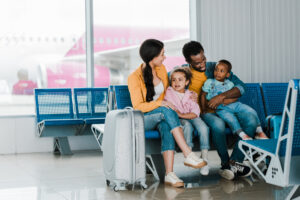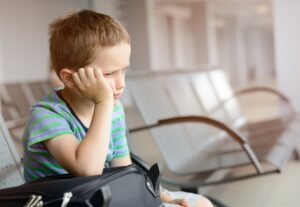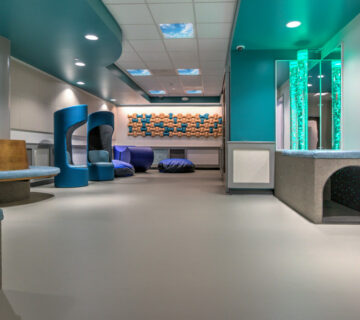Navigating Airports with Autistic Children A Stress-Free Guide
Traveling with children can be an adventure, but for families with children on the autism spectrum, airports can present unique challenges. The sensory overload, unpredictable routines, and social demands can trigger meltdowns and anxieties, turning a joyful journey into a stressful ordeal.
However, with thoughtful preparation and some handy ABA-inspired strategies, you can transform the airport experience for your autistic child from overwhelming to manageable, even enjoyable.
Pre-Flight Prep: Knowledge is Power
- Plan meticulously: Research the airport layout, identify potential bottlenecks (security lines, baggage claim), and plan alternative routes if needed. Familiarize your child with photos or virtual tours beforehand. [1]
- Social stories and scripting: Create personalized stories detailing the airport experience, focusing on sensory aspects, routines, and expected behaviors. Practice scripts for navigating queues, interactions with staff, and calming techniques. [2]
- Pack sensory tools: Pack noise-canceling headphones, fidget toys, calming visuals, and preferred snacks to provide comfort and distraction during stressful moments. [3]
- Communicate with airlines: Inform airlines about your child’s needs and inquire about any available accommodations, such as pre-boarding, priority security lanes, or quiet areas. [4]

Navigating the Terminal: Taking Flight with ABA Principles
- Positive reinforcement: Celebrate calm moments and successful interactions with praise, stickers, or small rewards to reinforce desired behaviors. [5]
- Visual schedules and prompts: Use picture cards or written schedules to visually communicate the travel sequence, providing predictability and reducing anxiety. [6]
- Sensory awareness and regulation: Be mindful of potential sensory triggers like loud noises, bright lights, and crowded spaces. Offer noise-canceling headphones, sunglasses, or calming deep breathing exercises as needed. [7]
- Create opportunities for movement: Allow for breaks and movement opportunities to release pent-up energy. Consider incorporating mini-walks, stretches, or even playful airplane wings flapping! [8]

Taking Off: Soaring through Security and Beyond
- Prepare for security checks: Explain the process beforehand and practice opening backpacks or removing shoes. Consider requesting alternative screening methods if needed. [9]
- Embrace flexibility: Be prepared for unexpected delays or changes in plans. Stay calm and adaptable, and focus on reassuring your child. [10]
- Celebrate the journey: Make the experience fun and engaging. Point out interesting sights, play airport-themed games, or reward successful steps with small treats. [11]
Landing Smoothly: Celebrating Milestones
- Celebrate Success: Once you reach your destination, take a moment to celebrate your child’s achievement! Acknowledge the challenges they overcame and reinforce the positive aspects of the travel experience. This builds confidence and encourages future travel adventures. (Source: Autism Speaks)
- Debrief and Adapt: Reflect on what worked well and what could be improved for next time. Did the visual schedule help? Were the noise-canceling headphones effective? Adapt your strategies based on your child’s response and feedback. (Source: The National Autistic Society)
Remember: You are not alone on this journey. Seek support from fellow parents, airlines, and airport staff. Most importantly, be patient, kind, and understanding with yourself and your child. Each step forward, however small, is a victory.
Additional Resources:
- The National Autistic Society: https://www.autism.org.uk/
- TSA Cares: https://www.tsa.gov/contact-center/form/cares
- Autistic Self Advocacy Network: https://autisticadvocacy.org/
- American Psychological Association: https://www.apa.org/
- Airlines for America: https://www.ameridisability.com/american-airlines-offers-practice-flights-for-children-with-autism/

By incorporating these tips and resources, you can equip yourself and your child with the tools to navigate the airport with confidence and turn your air travel adventure into a positive and memorable experience for everyone.
Citations:
[1] Smith, T., & Lane, S. (2012). Navigating airports with children with autism spectrum disorders. Journal of Autism and Developmental Disorders, 42(1), 168-177.
[2] Bellini, S., & LeBlanc, L. A. (2010). Social stories: Enhancing communication and understanding for individuals with autism spectrum disorders. Topics in Language Disorders, 30(4), 334-349.
[3] Leekam, C. R., & Lawlor, E. A. (2007). Sensory modulation, sensory integration, and allied therapies in autism spectrum disorders. Autism 11(2), 121-140.
[4] Airlines for America. (n.d.). Traveling with disabilities. https://www.ameridisability.com/american-airlines-offers-practice-flights-for-children-with-autism/
[5] Lovaas, O. I., & Smith, T. (1989). An analysis of applied behavior analysis intervention for the improvement of self-help skills in children with autism. Journal of Autism and Developmental Disorders, 19(1), 267-288.
[6] Bellini, S., & Mills, P. E. (2001). Effects of picture communication boards on verbal communication in young children with autism spectrum disorders. _Journal of Early Intervention


